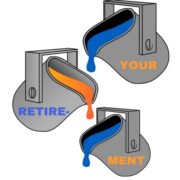FUNDING YOUR RETIREMENT
As originally appeared in The Jerusalem Post on Thursday, December 29, 2016.
Yesterday I was on a plane from Amsterdam to Seattle. I was surprised about the cross section of travelers on this flight. Usually when you fly from Europe to Seattle you’ll have some locals returning from vacation, and some Europeans heading out to a vacation. But on this flight I was surrounded with travelers from all over the globe. Next to me was seated a woman with a child and her husband. She was from Taiwan. In front of me was a man from Japan. Behind me was another couple, she was from Vancouver and he was European and across the aisle from me was a lady and her child and I couldn’t make out what language they were speaking. I was the only Seattleite in my area of the plane and I have been living in Israel from the past 24 years. This got me to thinking. Often when a couple comes to my office to discuss retirement planning the number one goal they have is to travel. But the issue of travel seems to me to be much more prevalent than just taking a Hawaiian vacation, or going to the Canadian Rockies. With families spread out across the globe, travel during retirement will be not to see the major wonders of the world rather be the ways to keep families in contact. To me this ups the ante, and the amount of money needed to fund travel will continue to grow.
The question will be how to fund a more expensive retirement than originally planned. One of the hottest issues in financial planning circles is with interest rates at such low levels how retirees can generate the income they need in order to meet their expenses. I’d like to focus on a strategy used by many financial advisors, myself included; It’s the bucket approach.
4% rule
Common financial planning wisdom says that in order to generate your desired retirement income you need to withdraw 4% from your portfolio each year. Let’s say that at retirement you have saved $400,000. Taking into account pensions, social security etc. you need another $16,000 to supplement your income.
Due to today’s investing climate, with near record low interest rates, it’s very questionable whether retirees will be able to achieve their goals by following old asset allocation strategies. This has led advisors to look for new ways to help their clients generate the income needed.
Fill Your Buckets
The bucket strategy calls for investors to divide their money into 3 buckets; A short-term liquid bucket, a slightly higher-yielding mid-term bucket, and then a more aggressive long-term bucket. Keep in mind that there are many versions to the strategy. When starting the strategy take a look at current market conditions and then set up the buckets. Most variations call for each bucket lasting 10 years. Based on current conditions, I would say that investors will be better served to cut the first bucket down to 5 years, and add the remaining years to the middle bucket.
Let’s go back to our example based on a $400,000 portfolio and a 65 year old freshly retired individual. The investor would take $80,000 in the first bucket and invest it in very liquid, very safe investments like CDs, government bonds (inflation protected) and highly rated corporate bonds. It would be set up that each year $16,000 becomes free. Any money left after 5 years would be transferred to bucket number 2.
The next bucket would have $240,000 to start with. It again would be invested that $16,000 comes due every year for the next 15 years. Here a combination of highly rated corporate bonds, hi-yield bonds, and government bonds would be used. The extra income generated from these investments should help keep the value of the money versus inflation, and leave over money to be invested in the 3rd bucket.
The third bucket is the growth bucket. Here you have at least $80,000 that has been invested for 20 years before being tapped. A basic equity allocation has the potential to appreciate significantly over this time period. A crummy 3.5% annual return will basically double the money ($160,000), and the hope is that after 20 years the market should do better than 3.5%. Even if it doesn’t, you will have 10 years of money to draw down.
You have now made it to 95 years old. We should all merit to live 120 years, but for financial planners, making it to 95 is considered a success. This is a very brief synopsis of the strategy, so speak with your advisor to see whether the bucket approach is right for you.
Past performance is not a reliable indicator of future results.
bucket
The information contained in this article reflects the opinion of the author and not necessarily the opinion of Portfolio Resources Group, Inc. or its affiliates. Aaron Katsman is author of the book Retirement GPS: How to Navigate Your Way to A Secure Financial Future with Global Investing (McGraw-Hill), and is a licensed financial professional both in the United States and Israel, and helps people who open investment accounts in the United States. Securities are offered through Portfolio Resources Group, Inc. (www.prginc.net). Member FINRA, SIPC, MSRB, FSI. For more information, call (02) 624-0995 visit www.aaronkatsman.com or email aaron@lighthousecapital.co.il.








